Really awesome photos! I would so love to hike there! Where were these photos taken Lori & Trond? Here are few taken a couple years back on vacation to Wyoming & Utah. What a blast!! ;D I can't recommend Capitol Reef enough, there were so many side canyons to explore around every bend in the access road. Loads of Castilleja and other natives that I didn't know.
Sorry, I forgot to mention where it is!
The first picture is from Ryfylke, southwest Norway, and the other is view from Tepuy Roraima, Venezuela. I have visited USA twice but only Florida. I realize - and have done for a long time - that I have much to see still!
Todd, it looks desolate but if I am correct you have shown some nice plants growing there!
Cliff, I have never seen Paper in the wild except in Turkey although they are common some places in Norway. (I do not mean the meadow papavers though!)
Trond, here is an example of a plant from the serpentine Tablelands...you would not think of Sarracenia growing on rocks! It truly is a rock garden plant here!
Terrific photos, Amy! I do love that kind of scenery! All the places shown look like fascinating spots to explore.
To answer your question, Amy, my recent photo was from Kananaskis Country, which is an area comprised of a few adjoining provincial parks in the eastern slope Rockies west of here. (From Stuart's backcountry ski trip on Sunday) here's a hint of what that neck of the woods (not exactly the same spot) looks like now!
Trond, here is an example of a plant from the serpentine Tablelands...you would not think of Sarracenia growing on rocks! It truly is a rock garden plant here!
Todd, I guess it is wetter in spring? Or is it a special ecotype tolerating the special soil there? I have not tried Sarracenia in my garden assuming it needed a bog.
Isn't it truly amazing how beautiful snow can be...!
Yes - on a picture ;) Last night we had our first real freezing - 2C. The slush from yesterday is frozen solid, however no problem driving. I like snow when I'm in the mountains skiing but not here - or to be precise - not the kind of snow we get here.
Todd - when I visited St. John's in Newfoundland for a recent NARGs Annual meeting there, some of the spots we visited seemed just covered with Sarracenia purpurea - also Kalmia. Just amazing! Fran
In Minnesota, Sarracenia is most often found in relatively young bogs that still have a lot of bounce potential nearer to the edge of lakes.
Ha, muskeg areas are kind of fun to walk around in, aren't they? So long as you're wearing chest waders... and don't stand around in the same spot for too long! :D
This is a really lousy picture (sorry) but I was kind of fascinated by the size comparison between an Erigeron aureus... which was probably less than 2" tall... but absolutely hulking over a miniscule Erigeron humilis!
Anne, these plants are also from that same scree slope.
In Minnesota, Sarracenia is most often found in relatively young bogs that still have a lot of bounce potential nearer to the edge of lakes.
Ha, muskeg areas are kind of fun to walk around in, aren't they? So long as you're wearing chest waders... and don't stand around in the same spot for too long! :D
Or with sandals! Which drain the water quickly!
Lori wrote:
This is a really lousy picture (sorry) but I was kind of fascinated by the size comparison between an Erigeron aureus... which was probably less than 2" tall... but absolutely hulking over a miniscule Erigeron humilis!
Ha, muskeg areas are kind of fun to walk around in, aren't they? So long as you're wearing chest waders... and don't stand around in the same spot for too long! :D
Depending on what I am doing, I will just go barefoot, wear some tenners I don't mind getting wet, or use snowshoes. And yes, never stand in one place too long!
Arisaema ringens berries. Within 2 months we may experience -15F; betting this is the last fresh flower of the season. Erigeron compositus in a very sandy, raised bed with some happy looking very xeric moss; which spreads quite rapidly but remains shorter than 3mm. Charles Swanson NE MA USA z6a +/-
Erigeron compositus and Arisaema ringens berries. Charles Swanson MA USA
Wow, just look at that fat ear of red corn ;) Arisaema seed is beautiful. Typically when I find them ripe like this, I'll check to see whether the seeds are ready to drop off when handled, and sow the seed directly in the garden by scratching them in. A couple years ago, I had my first seed set on Arisaema heterophyllum, but set seed was so late, that I ended up chopping through a deep layer of snow and ice mid winter to find the seed head, sowed the seed indoors, and it came up!
The last plant standing in my garden is self-sown seedling from Allium thunbergii 'Ozawa' that grows much taller and this year flowered very late,
The images are flooding in today ... all wonderful!
One from Switzerland from me ...
Globularia profile
Great view. You do realize Cliff, that everyone will be looking for this elusive species; the lovely Globularia profile, in the seed exchange! ;) Is it Globularia cordifolia?
Arisaema seed is lovely! Lori, I'm into that time of year (for weeks, already!) where the simple sight of bare (snowless) ground (apart from little patches under trees) seems very exotic!
Santa came early and I am learning the ropes with a new camera! A big step up from my old one, with the down side that I wont be able to afford lenses anytime soon to give me the macro and telephoto range I'm used to! (Have to look into used, and discount outlets yet....) It came with an 18-55 mm lens, and while that's not macro, I think I will be able to focus well enough on small things to make do (and the resolution will easily make up for the lack of closeness as long as I'm focussed!)-- still practising!
Beautiful photo, Cohan! Looks like you are mastering that new camera already. Every bit of colour (especially red) really is a delight to the eye at this time of year.
The images are flooding in today ... all wonderful!
One from Switzerland from me ...
Globularia profile
Great view. You do realize Cliff, that everyone will be looking for this elusive species; the lovely Globularia profile, in the seed exchange! ;) Is it Globularia cordifolia?
Not everyone, Mark, for once not me! It is nothing wrong with the plant or the pic but I have tried the genus several times without luck, and now I want to try other gems ;D
Lori, a beautiful view!
Cohan, I am looking forward to see all the wonderful places through your new camera ;)
Thanks, Lori and Trond :) Gradually I'm figuring out settings, but one of my funnier learning moments was: I was trying to focus on a frosty twig tip, through the viewfinder, the camera shows multiple possible focus points, you can choose multi point, centre, side etc, and instead of the centre focus point lighting up, where the twig was, I was only getting one spot off to the side showing focus, which made no sense- until I finally realised I was somehow looking at only one side of the viewfinder, and that focus spot 'off to the side' was actually the centre! Note to self: hold camera straight and look squarely through the viewfinder! Lori's comment about welcome colour at this time of year is very true- even a few dried leaves are a welcome break from white-not a great shot, but a nice bit of semi-golden colour with the low sun hitting them-- Lonicera involucrata..
Congratulations, Trond-- only about 6 weeks after me ;D Nice lights! I'm just depening on snow/frost and moonlight ;) if we don't have those, it will be a little plain...lol
Nice little 'stinkweed' Lori seems to be a very charming genus apart from the obvious ;)
Yeah, too bad our only example of the genus Thlaspi is an introduced agricultural weed, as are the vast majority of our weeds.
Indeed. though I must say it is low on my list of bothersome weeds-- very effective seeder, but so easy to pull! And only seems to grow in disturbed ground, so even in the bush on the farm, which has been grazed for decades, only makes sporadic and non-troublesome appearances.. Far more pernicious are the clovers (I'm stunned to hear of people planting them in they yards as a low maintenance lawn! I'd far rather keep dandelions- at least they don't creep!), and worst of all is Ranunculus acris which grows in wetlands which were mostly safe from the other agricultural weeds :(
Congratulations, Trond-- only about 6 weeks after me ;D Nice lights! I'm just depening on snow/frost and moonlight ;) if we don't have those, it will be a little plain...lol
Nice little 'stinkweed' Lori seems to be a very charming genus apart from the obvious ;)
Cohan, I honestly do hope my spring isn't 6 weeks after yours ;D
Both the Thlaspi and the Veronica are stunning, Lori! Selfsown?
A very Merry Christmas and a Happy and floriferous New Year to all forum administrators, posters, lurkers and visitors from an unseasonably warm Lancashire.
Comments
Trond Hoy
Re: Image of the day
Mon, 12/05/2011 - 4:39amSorry, I forgot to mention where it is!
The first picture is from Ryfylke, southwest Norway, and the other is view from Tepuy Roraima, Venezuela.
I have visited USA twice but only Florida. I realize - and have done for a long time - that I have much to see still!
Todd Boland
Re: Image of the day
Mon, 12/05/2011 - 10:53amIncredible sceneries.....our most alpine areas are the serpentine Tablelands.
Cliff Booker
Re: Image of the day
Tue, 12/06/2011 - 2:34amLovely hiking country, Todd.
Falzarego in the Dolomites featuring Papaver rhaeticum. One of our favourite spots.
Trond Hoy
Re: Image of the day
Tue, 12/06/2011 - 12:49pmTodd, it looks desolate but if I am correct you have shown some nice plants growing there!
Cliff, I have never seen Paper in the wild except in Turkey although they are common some places in Norway. (I do not mean the meadow papavers though!)
Todd Boland
Re: Image of the day
Tue, 12/06/2011 - 4:30pmTrond, here is an example of a plant from the serpentine Tablelands...you would not think of Sarracenia growing on rocks! It truly is a rock garden plant here!
Lori S. (not verified)
Re: Image of the day
Tue, 12/06/2011 - 7:29pmTerrific photos, Amy! I do love that kind of scenery!
All the places shown look like fascinating spots to explore.
To answer your question, Amy, my recent photo was from Kananaskis Country, which is an area comprised of a few adjoining provincial parks in the eastern slope Rockies west of here. (From Stuart's backcountry ski trip on Sunday) here's a hint of what that neck of the woods (not exactly the same spot) looks like now!
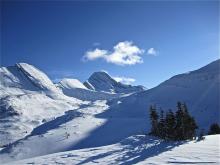
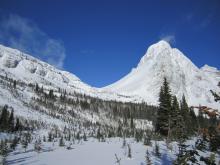

Mark McDonough
Re: Image of the day
Tue, 12/06/2011 - 8:26pmSnowy!
Here, its been unseasonably warm; reached 60 F today, didn't even need a coat...hard to believe it is December.
Richard T. Rodich
Re: Image of the day
Tue, 12/06/2011 - 8:47pmIsn't it truly amazing how beautiful snow can be...!
Anne Spiegel
Re: Image of the day
Wed, 12/07/2011 - 4:48amLori, have you explored the screes in your photo? Looks like my kind of place.
Lori S. (not verified)
Re: Image of the day
Wed, 12/07/2011 - 5:21amYes, Anne, every time we hike there! That particular slope in the photo is pretty high up and often not in bloom until mid to late August.
Amy Olmsted
Re: Image of the day
Wed, 12/07/2011 - 5:26amThanks lori! someday I'll try to get there.....or at least someplace close.
what a spectacular spot for hiking or skiing! Lucky you!
Trond Hoy
Re: Image of the day
Wed, 12/07/2011 - 7:39amTodd, I guess it is wetter in spring? Or is it a special ecotype tolerating the special soil there?
I have not tried Sarracenia in my garden assuming it needed a bog.
Trond Hoy
Re: Image of the day
Wed, 12/07/2011 - 7:43amYes - on a picture ;)
Last night we had our first real freezing - 2C. The slush from yesterday is frozen solid, however no problem driving. I like snow when I'm in the mountains skiing but not here - or to be precise - not the kind of snow we get here.
Todd Boland
Re: Image of the day
Wed, 12/07/2011 - 12:40pmTrond, the water table is just below the surface where the Sarracenia grow so the picture is deceiving!
Trond Hoy
Re: Image of the day
Thu, 12/08/2011 - 3:45amThen I have to construct a place with high water table ;)
Howey (not verified)
Re: Image of the day
Thu, 12/08/2011 - 4:02amTodd - when I visited St. John's in Newfoundland for a recent NARGs Annual meeting there, some of the spots we visited seemed just covered with Sarracenia purpurea - also Kalmia. Just amazing! Fran
Frances Howey
London, Ontario, Canada
Zone 5b
Anne Spiegel
Re: Image of the day
Thu, 12/08/2011 - 4:36amWhat do you typically see in those screes?
Richard T. Rodich
Re: Image of the day
Thu, 12/08/2011 - 7:41amIn Minnesota, Sarracenia is most often found in relatively young bogs that still have a lot of bounce potential nearer to the edge of lakes.
Lori S. (not verified)
Re: Image of the day
Thu, 12/08/2011 - 6:20pmAnne, probably the best way I can answer is to link to some of these hike reports:
http://nargs.org/smf/index.php?topic=416.msg4041#msg4041
http://nargs.org/smf/index.php?topic=384.msg3763#msg3763
Lori S. (not verified)
Re: Image of the day
Thu, 12/08/2011 - 10:06pmHa, muskeg areas are kind of fun to walk around in, aren't they? So long as you're wearing chest waders... and don't stand around in the same spot for too long! :D
Lori S. (not verified)
Re: Image of the day
Thu, 12/08/2011 - 10:11pmThis is a really lousy picture (sorry) but I was kind of fascinated by the size comparison between an Erigeron aureus... which was probably less than 2" tall... but absolutely hulking over a miniscule Erigeron humilis!
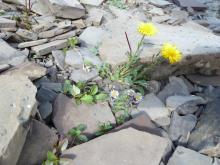
Anne, these plants are also from that same scree slope.
Trond Hoy
Re: Image of the day
Fri, 12/09/2011 - 6:44amOr with sandals! Which drain the water quickly!
I need my loupe :)
Richard T. Rodich
Re: Image of the day
Fri, 12/09/2011 - 3:17pmDepending on what I am doing, I will just go barefoot, wear some tenners I don't mind getting wet, or use snowshoes. And yes, never stand in one place too long!
Lori S. (not verified)
Re: Image of the day
Fri, 12/09/2011 - 10:56pmI guess the water must be a lot warmer in Minnesota and Norway... ;)
Campanula topaliana:
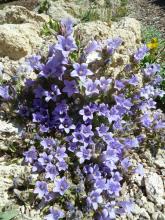
Trond Hoy
Re: Image of the day
Sat, 12/10/2011 - 2:27amYes, of course, as you can see here. It's hot even in winter:
http://www.nrk.no/nyheter/distrikt/nrk_sogn_og_fjordane/1.7910419
PS A beutiful bellflower! I choose that one to crabs ;)
externmed (not verified)
Images from Massachusetts USA garden Dec. 11
Sun, 12/11/2011 - 1:05pmArisaema ringens berries. Within 2 months we may experience -15F; betting this is the last fresh flower of the season. Erigeron compositus in a very sandy, raised bed with some happy looking very xeric moss; which spreads quite rapidly but remains shorter than 3mm.
Charles Swanson NE MA USA z6a +/-
externmed (not verified)
addendum to last post
Sun, 12/11/2011 - 1:11pmErigeron compositus and Arisaema ringens berries.
Charles Swanson MA USA
Mark McDonough
Re: addendum to last post
Sun, 12/11/2011 - 7:47pmWow, just look at that fat ear of red corn ;) Arisaema seed is beautiful. Typically when I find them ripe like this, I'll check to see whether the seeds are ready to drop off when handled, and sow the seed directly in the garden by scratching them in. A couple years ago, I had my first seed set on Arisaema heterophyllum, but set seed was so late, that I ended up chopping through a deep layer of snow and ice mid winter to find the seed head, sowed the seed indoors, and it came up!
The last plant standing in my garden is self-sown seedling from Allium thunbergii 'Ozawa' that grows much taller and this year flowered very late,

Lori S. (not verified)
Re: Image of the day
Sat, 12/17/2011 - 9:29amThe Arisaema seed is really gorgeous!
An alpine scene from northern Banff N.P.:
Cliff Booker
Re: Image of the day
Sat, 12/17/2011 - 10:19amThe images are flooding in today ... all wonderful!
One from Switzerland from me ...
Globularia profile
Mark McDonough
Re: Image of the day
Sat, 12/17/2011 - 10:31amGreat view. You do realize Cliff, that everyone will be looking for this elusive species; the lovely Globularia profile, in the seed exchange! ;)
Is it Globularia cordifolia?
cohan (not verified)
Re: Image of the day
Sat, 12/17/2011 - 10:57amArisaema seed is lovely!
Lori, I'm into that time of year (for weeks, already!) where the simple sight of bare (snowless) ground (apart from little patches under trees) seems very exotic!
Santa came early and I am learning the ropes with a new camera! A big step up from my old one, with the down side that I wont be able to afford lenses anytime soon to give me the macro and telephoto range I'm used to! (Have to look into used, and discount outlets yet....) It came with an 18-55 mm lens, and while that's not macro, I think I will be able to focus well enough on small things to make do (and the resolution will easily make up for the lack of closeness as long as I'm focussed!)-- still practising!
Lori S. (not verified)
Re: Image of the day
Sat, 12/17/2011 - 11:02amBeautiful photo, Cohan! Looks like you are mastering that new camera already. Every bit of colour (especially red) really is a delight to the eye at this time of year.
Trond Hoy
Re: Image of the day
Sat, 12/17/2011 - 11:03amNot everyone, Mark, for once not me! It is nothing wrong with the plant or the pic but I have tried the genus several times without luck, and now I want to try other gems ;D
Lori, a beautiful view!
Cohan, I am looking forward to see all the wonderful places through your new camera ;)
cohan (not verified)
Re: Image of the day
Sat, 12/17/2011 - 11:25amThanks, Lori and Trond :) Gradually I'm figuring out settings, but one of my funnier learning moments was: I was trying to focus on a frosty twig tip, through the viewfinder, the camera shows multiple possible focus points, you can choose multi point, centre, side etc, and instead of the centre focus point lighting up, where the twig was, I was only getting one spot off to the side showing focus, which made no sense- until I finally realised I was somehow looking at only one side of the viewfinder, and that focus spot 'off to the side' was actually the centre! Note to self: hold camera straight and look squarely through the viewfinder!
Lori's comment about welcome colour at this time of year is very true- even a few dried leaves are a welcome break from white-not a great shot, but a nice bit of semi-golden colour with the low sun hitting them-- Lonicera involucrata..
Trond Hoy
Re: Image of the day
Sat, 12/17/2011 - 12:18pmThe first real snowfall this winter - 5cm today!
Lori S. (not verified)
Re: Image of the day
Sat, 12/17/2011 - 2:43pmThlaspi kurdicum:
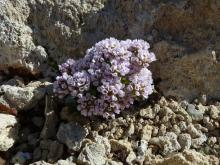
cohan (not verified)
Re: Image of the day
Sat, 12/17/2011 - 7:43pmCongratulations, Trond-- only about 6 weeks after me ;D
Nice lights! I'm just depening on snow/frost and moonlight ;) if we don't have those, it will be a little plain...lol
Nice little 'stinkweed' Lori seems to be a very charming genus apart from the obvious ;)
Lori S. (not verified)
Re: Image of the day
Sat, 12/17/2011 - 8:40pmYeah, too bad our only example of the genus Thlaspi is an introduced agricultural weed, as are the vast majority of our weeds.
cohan (not verified)
Re: Image of the day
Sat, 12/17/2011 - 9:14pmIndeed. though I must say it is low on my list of bothersome weeds-- very effective seeder, but so easy to pull! And only seems to grow in disturbed ground, so even in the bush on the farm, which has been grazed for decades, only makes sporadic and non-troublesome appearances..
Far more pernicious are the clovers (I'm stunned to hear of people planting them in they yards as a low maintenance lawn! I'd far rather keep dandelions- at least they don't creep!), and worst of all is Ranunculus acris which grows in wetlands which were mostly safe from the other agricultural weeds :(
Lori S. (not verified)
Re: Image of the day
Sat, 12/17/2011 - 10:39pmA stunning Turkish alpine, Veronica bombycina ssp. bolkardaghensis:
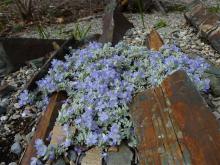
cohan (not verified)
Re: Image of the day
Sat, 12/17/2011 - 11:52pmWow-- stunning is right-- great foliage and flowers!
Trond Hoy
Re: Image of the day
Sun, 12/18/2011 - 4:17amCohan, I honestly do hope my spring isn't 6 weeks after yours ;D
Both the Thlaspi and the Veronica are stunning, Lori! Selfsown?
cohan (not verified)
Re: Image of the day
Sun, 12/18/2011 - 12:25pmNot possible! 6 weeks after my spring is winter!
Cliff Booker
Re: Image of the day
Tue, 12/20/2011 - 8:31amQuiet on the forum at the moment, so a few images to enhance (?) your viewing pleasure.
Dianthus and grasses
Insects
Potentilla nitida
Pulsatilla alpina ssp. apiifolia
Saxifraga oppositifolia
Potentilla nitida
Potentilla nitida
Todd Boland
Re: Image of the day
Tue, 12/20/2011 - 10:47amI'm longing for spring already and winter has just begun!
cohan (not verified)
Re: Image of the day
Tue, 12/20/2011 - 11:26amAlways a delight to see these wonderful places :)
Anne Spiegel
Re: Image of the day
Wed, 12/21/2011 - 8:32amCliff, your pictures are making me homesick for my "second home".
Panayoti Kelaidis
Re: Image of the day
Thu, 12/22/2011 - 6:18pmLori's stunning image of Veronica bombycina v. bolgardagensis really can't be beat...your garden must be something! Super rock work.
But I have recently been sorting images and found my shots of what I think is my favorite of the genus: see attached!
The first three are bolgardagensis, and the last is Veronica thymoides v. pseudocinerea...Love those blues!
Cliff Booker
Re: Image of the day
Fri, 12/23/2011 - 11:50amBeautiful Veronicas, Panayoti.
A very Merry Christmas and a Happy and floriferous New Year to all forum administrators, posters, lurkers and visitors from an unseasonably warm Lancashire.
Callianthemum kernerianum
Pages